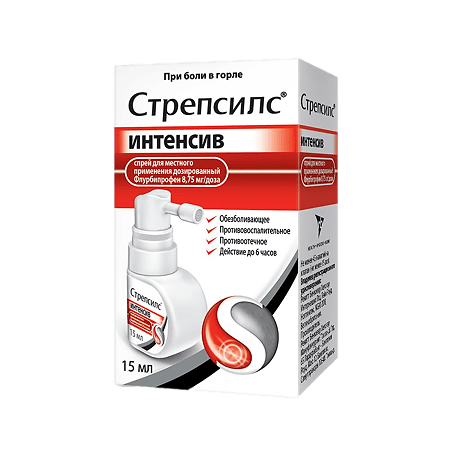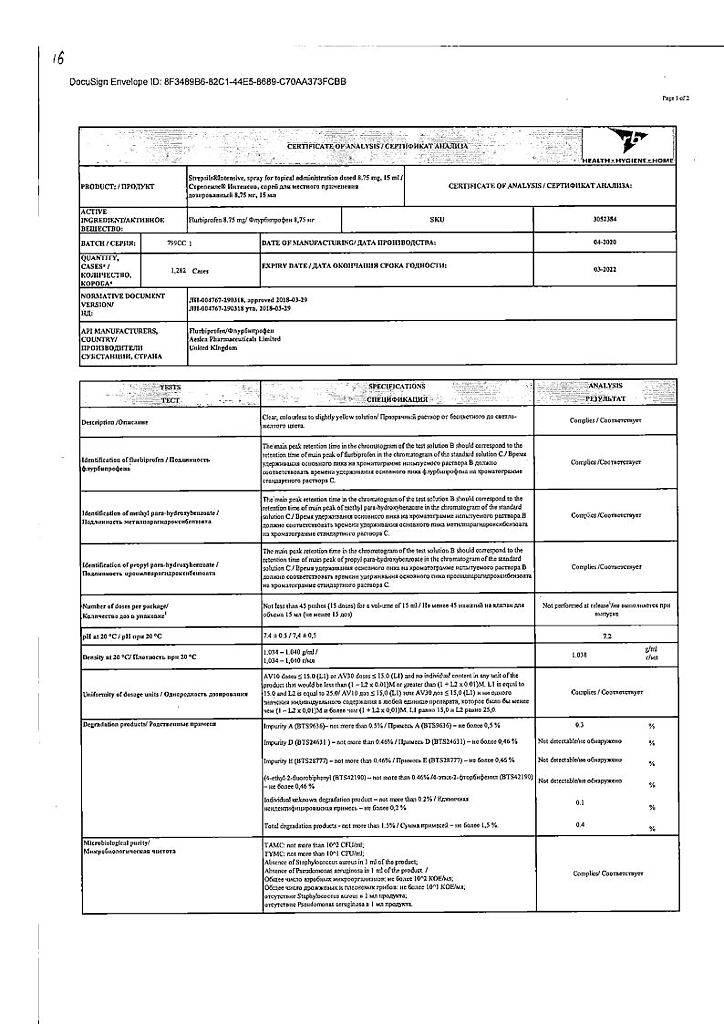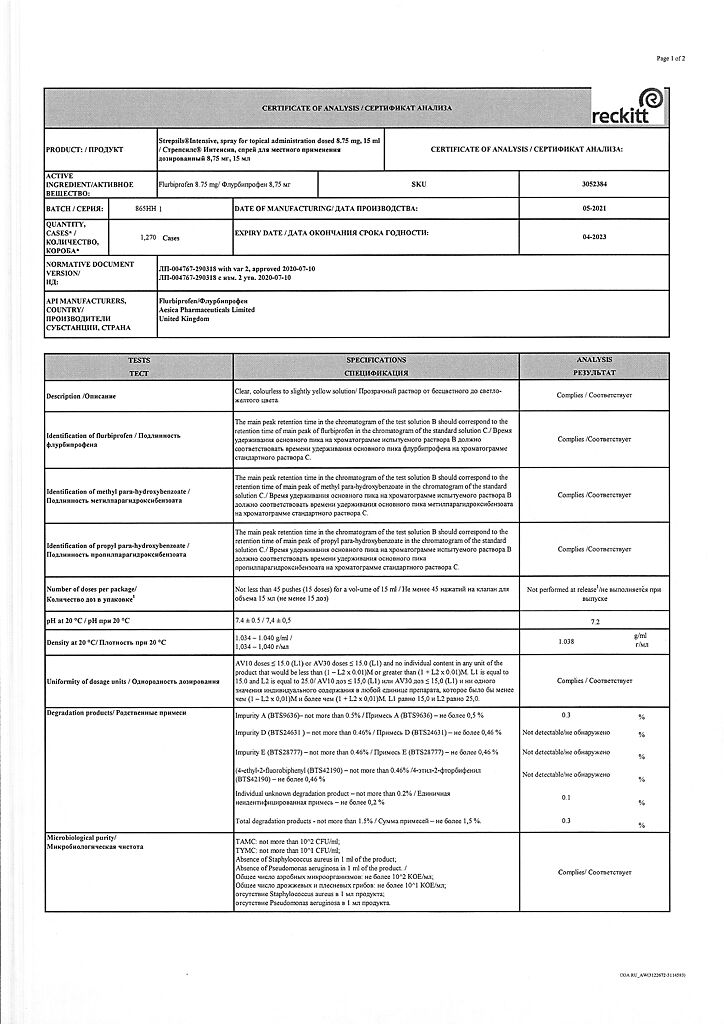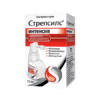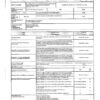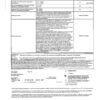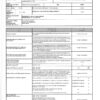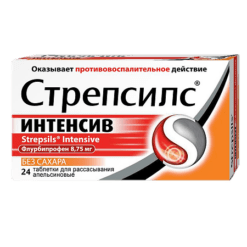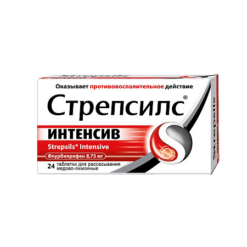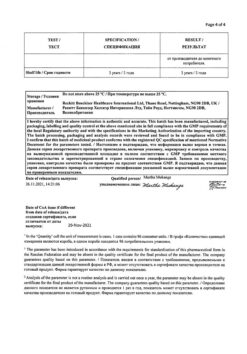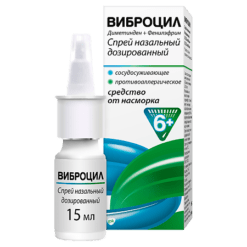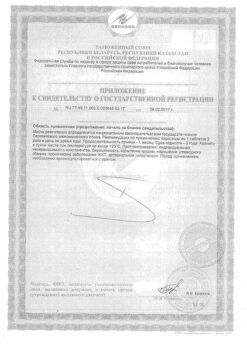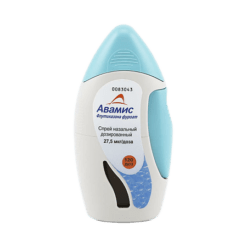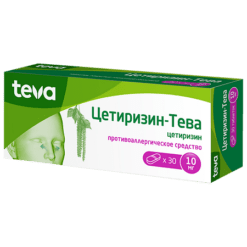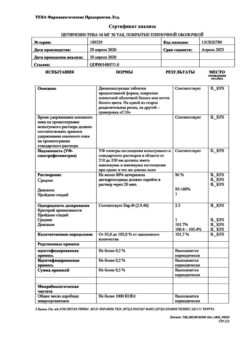No products in the cart.
Strepsils Intensive, spray 8.75mg/dose 15 ml
€11.40 €9.98
Description
Flurbiprofen is a nonsteroidal anti-inflammatory drug (NSAID), a propionic acid derivative.
Flurbiprofen has analgesic, anti-inflammatory and antipyretic effect due to inhibition of cyclooxygenase-1 (COX-1) and cyclooxygenase-2 (COX-2), with some selectivity to COX-1, resulting in reduced production of prostaglandins – mediators of pain, inflammation and hyperthermia.
When using the drug in a single dose (3 pressings on the dispenser), reduction of pain and difficulty in swallowing is noted after 5 minutes, a significant decrease in the intensity of pain – after 20 minutes, reduction of edema after 30 minutes after application. Analgesic and anti-edema effect of the drug lasts up to 6 hours.
Pharmacokinetics
When a single dose of the drug is applied (3 presses on the dispenser) to the oropharyngeal mucosa, flurbiprofen is quickly absorbed and determined in the blood plasma after 2-5 minutes. Maximum concentration of flurbiprofen in plasma is reached 30 minutes after application and is 1.6 mcg/ml, which is 4 times lower than when taking flurbiprofen 50 mg orally. Flurbiprofen is rapidly bound to plasma proteins and distributed throughout the body.
Flurbiprofen is metabolized mainly by hydroxylation and is excreted by the kidneys with a half-life (T1/2) of 3-6 hours. About 20-25% of the oral dose of flurbiprofen is excreted unchanged by the kidneys.
Indications
Indications
As a symptomatic remedy for
relief of sore throat in infectious and inflammatory diseases of the upper
respiratory tract.
Pharmacological effect
Pharmacological effect
Flurbiprofen is a nonsteroidal anti-inflammatory drug (NSAID) derived from propionic acid.
Flurbiprofen has an analgesic, anti-inflammatory and antipyretic effect due to the suppression of cyclooxygenase-1 (COX-1) and cyclooxygenase-2 (COX-2), with some selectivity towards COX-1, resulting in a decrease in the production of prostaglandins – mediators of pain, inflammation and hyperthermic reaction.
When using the drug in a single dose (3 clicks on the dispenser), a decrease in pain and difficulty swallowing is noted after 5 minutes, a significant decrease in pain intensity – after 20 minutes, and a decrease in swelling 30 minutes after use. The analgesic and decongestant effect of the drug lasts up to 6 hours.
Pharmacokinetics
When a single dose of the drug is applied (3 clicks on the dispenser) to the mucous membrane of the oropharynx, flurbiprofen is quickly absorbed and detected in the blood plasma after 2-5 minutes. The maximum concentration of flurbiprofen in the blood plasma is reached 30 minutes after administration and is 1.6 mcg/ml, which is 4 times lower than when taking 50 mg of flurbiprofen orally. Flurbiprofen quickly binds to blood plasma proteins and is distributed throughout the body.
Flurbiprofen is metabolized mainly by hydroxylation and excreted by the kidneys, the half-life (T1/2) is 3-6 hours. Approximately 20-25% of an oral dose of flurbiprofen is excreted unchanged by the kidneys.
Special instructions
Special instructions
It is recommended to take the drug for the shortest possible course and in the minimum effective dose necessary to eliminate symptoms.
When symptoms of gastropathy appear, careful monitoring is indicated, including esophagogastroduodenoscopy, a complete blood count (hemoglobin determination), and a stool test for occult blood.
If it is necessary to determine 17-ketosteroids, the drug should be discontinued 48 hours before the study.
Patients with renal or hepatic insufficiency, as well as elderly patients and patients taking diuretics, should consult a doctor before using the drug, as there is a risk of deterioration in renal function. With short-term use of the drug, the risk is negligible.
Patients with arterial hypertension, including a history of and/or chronic heart failure, should consult a doctor before using the drug, since the drug may cause fluid retention, increased blood pressure and edema.
Information for women planning pregnancy: the drug inhibits cyclooxygenase and prostaglandin synthesis and may affect ovulation, disrupting female reproductive function (reversible after discontinuation of treatment).
During the treatment period, alcohol consumption is not recommended.
If irritation occurs in the oral cavity, skin rash, damage to the mucous membrane or other manifestations of an allergic reaction, you should stop using the drug and consult a doctor.
If existing symptoms worsen or new ones appear, including signs of a bacterial infection, you should immediately consult a doctor to review therapy.
Active ingredient
Active ingredient
Flurbiprofen
Composition
Composition
1 dose of spray (3 clicks on the dispenser) contains:
active ingredient:
flurbiprofen 8.75 mg;
excipients:
betadex 22.83 mg,
sodium hydrogen phosphate dodecahydrate 17.19 mg,
citric acid monohydrate 0.63 mg,
methyl parahydroxybenzoate 1.18 mg,
propyl parahydroxybenzoate 0.24 mg,
sodium hydroxide 1.30 mg,
mint flavor (PHL 175628) 1.08 mg,
cherry flavor (PHL 175629) 1.35 mg,
N-2,3-trimethyl-2-isopropylbutanamide 0.54 mg,
sodium saccharinate 0.27 mg,
hydroxypropyl betadex 12.09 mg,
water 492.55 mg.
Pregnancy
Pregnancy
The use of the drug is contraindicated in the third trimester of pregnancy.
The use of flurbiprofen should be avoided in the first and second trimesters of pregnancy; if it is necessary to use the drug, you should consult your doctor.
There is evidence that flurbiprofen can pass into breast milk without any negative consequences for the baby’s health, however, due to possible side effects, the use of the drug during breastfeeding is not recommended.
Contraindications
Contraindications
Hypersensitivity to flurbiprofen or any of the components of the drug.
A history of hypersensitivity reactions (bronchial asthma, bronchospasm, rhinitis, Quincke’s edema, urticaria, recurrent polyposis of the nose or paranasal sinuses) in response to the use of acetylsalicylic acid or other NSAIDs.
Erosive and ulcerative diseases of the gastrointestinal tract (including peptic ulcer of the stomach and duodenum), ulcerative bleeding in the active phase or history (two or more confirmed episodes of peptic ulcer or ulcerative bleeding).
Bleeding or perforation of a gastrointestinal ulcer, ulcerative colitis, a history of hemorrhagic and hematopoietic disorders caused by the use of NSAIDs.
Pregnancy (III trimester).
Breastfeeding period.
Children’s age up to 12 years.
Severe liver failure or active liver disease.
Severe renal failure (creatinine clearance <30 ml/min).
Decompensated heart failure.
The period after coronary artery bypass surgery.
Confirmed hyperkalemia.
Glucose-6-phosphate dehydrogenase deficiency.
Hemophilia and other bleeding disorders (including hypocoagulation), hemorrhagic diathesis.
With caution
If you have the diseases and/or conditions listed in this section, you should consult a doctor before using the drug.
Concomitant use of other NSAIDs; a history of a single episode of gastric ulcer or gastrointestinal ulcer bleeding; history of gastrointestinal tract diseases (ulcerative colitis, Crohn’s disease), gastritis, enteritis, colitis, Helicobacter pylori infection; bronchial asthma or allergic diseases in the acute stage or in history – bronchospasm may develop; systemic lupus erythematosus and other systemic autoimmune connective tissue diseases (increased risk of developing aseptic meningitis) – with short-term use of flurbiprofen the risk is negligible; arterial hypertension and/or heart failure, edema; renal failure, including with dehydration (creatinine clearance less than 60 ml/min), nephrotic syndrome, liver failure, liver cirrhosis with portal hypertension, hyperbilirubinemia (with short-term use of flurbiprofen the risk is negligible); simultaneous use of medications that may increase the risk of ulcers or bleeding, in particular oral glucocorticosteroids (including prednisolone), anticoagulants (including warfarin), antiplatelet agents (including acetylsalicylic acid, clopidogrel), selective serotonin reuptake inhibitors (including citalopram, fluoxetine, paroxetine, sertraline); alcoholism; I-II trimester of pregnancy; old age.
Side Effects
Side Effects
The risk of side effects can be minimized if the drug is used for a short course and in the minimum effective dose required to eliminate symptoms.
The following adverse reactions were observed with short-term use of the drug. When treating chronic conditions and with long-term use, other adverse reactions may occur.
The incidence of adverse reactions was assessed based on the following criteria: very often (≥ 1/10), often (from ≥ 1/100 to < 1/10), infrequently (from ≥ 1/1000 to < 1/100), rarely (from ≥ 1/10,000 to < 1/1000), very rarely (< 1/10,000), frequency unknown (data on no frequency estimates available).
Blood and lymphatic system disorders:
Frequency unknown: anemia, thrombocytopenia.
Nervous system disorders:
Common: dizziness, headache, paresthesia.
Uncommon: drowsiness.
Immune system disorders:
Rarely: anaphylactic reactions.
Cardiac disorders:
Frequency unknown: heart failure, edema.
Vascular disorders:
Frequency unknown: increased blood pressure.
Disorders of the respiratory system, chest and mediastinal organs:
Common: feeling of irritation in the throat.
Uncommon: exacerbation of bronchial asthma and bronchospasm, shortness of breath, wheezing, blisters in the mouth and pharynx, pharyngeal hypoesthesia (decreased sensitivity in the mouth and pharynx).
Gastrointestinal disorders:
Common: diarrhea, oral ulceration, nausea, oral pain, oral paresthesia, oral and pharyngeal pain, oral discomfort (warmth, burning or tingling sensation in the mouth).
Uncommon: bloating, abdominal pain, constipation, dry mouth, dyspepsia, flatulence, glossalgia (burning mouth syndrome), dysgeusia (change in taste perception), oral dysesthesia, vomiting.
Disorders of the skin and subcutaneous tissues:
Uncommon: skin rash, itching.
Not known: severe skin reactions such as bullous reactions including Stevens-Johnson syndrome and toxic epidermal necrolysis (Lyell’s syndrome).
Disorders of the liver and biliary tract:
Frequency unknown: hepatitis.
Mental disorders:
Uncommon: insomnia.
Others:
Uncommon: fever, pain.
If any of the side effects indicated in the instructions get worse or you notice any other side effects not listed in the instructions, tell your doctor.
Interaction
Interaction
The simultaneous use of the drug with the following drugs should be avoided:
Acetylsalicylic acid: with the exception of low doses of acetylsalicylic acid (no more than 75 mg per day) prescribed by a doctor, since combined use may increase the risk of side effects.
Other NSAIDs, including ibuprofen and selective cyclooxygenase-2 inhibitors: The simultaneous use of two or more NSAIDs should be avoided due to a possible increased risk of side effects.
Use with caution simultaneously with the following medications:
Anticoagulants: NSAIDs may enhance the effects of anticoagulants, including warfarin.
Antiplatelet agents and selective serotonin reuptake inhibitors: increased risk of gastrointestinal bleeding.
Antihypertensives (ACE inhibitors and angiotensin II antagonists) and diuretics: NSAIDs may reduce the effectiveness of these drugs and may increase nephrotoxicity due to cyclooxygenase inhibition, especially in patients with impaired renal function (it is necessary to ensure adequate fluid replacement in such patients).
Ethanol: May increase the risk of adverse reactions, especially gastrointestinal bleeding.
Cardiac glycosides: simultaneous use of NSAIDs and cardiac glycosides can lead to worsening heart failure, a decrease in glomerular filtration rate and an increase in the concentration of cardiac glycosides in the blood plasma.
Cyclosporine: increased risk of nephrotoxicity.
Glucocorticosteroids: increased risk of gastrointestinal ulceration and gastrointestinal bleeding.
Lithium preparations: there is evidence of the likelihood of an increase in the concentration of lithium in the blood plasma during the use of NSAIDs.
Methotrexate: there is evidence of the likelihood of an increase in the concentration of methotrexate in the blood plasma during the use of NSAIDs. It is necessary to take NSAIDs 24 hours before or after taking methotrexate.
Mifepristone: NSAIDs should be started no earlier than 8-12 days after stopping mifepristone, as NSAIDs may reduce the effectiveness of mifepristone.
Quinolone antibiotics: In patients receiving concomitant treatment with NSAIDs and quinolone antibiotics, the risk of seizures may be increased.
Tacrolimus: when used together with NSAIDs, there may be an increased risk of nephrotoxicity.
Zidovudine: when used together with NSAIDs, there may be an increased risk of hematotoxicity.
Oral hypoglycemic drugs: changes in blood glucose concentrations are possible (it is recommended to increase the frequency of monitoring blood glucose concentrations).
Phenytoin: an increase in the concentration of phenytoin in the blood serum is possible (monitoring the concentration of phenytoin in the blood serum and, if necessary, dose adjustment is recommended).
Potassium-sparing diuretics: Concomitant use of potassium-sparing diuretics and flurbiprofen may lead to hyperkalemia.
Probenecid and sulfinpyrazone: Medicines containing probenecid or sulfinpyrazone may delay the elimination of flurbiprofen.
Tolbutamide and antacids: To date, studies have shown no interactions between flurbiprofen and tolbutamide or antacids.
Overdose
Overdose
Symptoms: nausea, vomiting, pain in the epigastric region, less often diarrhea. Tinnitus, headache, and gastrointestinal bleeding are also possible. In more severe cases, the following manifestations from the central nervous system are observed: drowsiness, rarely – agitation, blurred vision, disorientation or coma. In rare cases, patients experience seizures.
In cases of severe NSAID poisoning, metabolic acidosis and an increase in prothrombin time may develop, which is likely due to the effect on the action of blood coagulation factors. Acute renal failure and liver damage, decreased blood pressure, respiratory depression and cyanosis may develop. In patients with bronchial asthma, exacerbation of this disease is possible.
Treatment: symptomatic, with mandatory maintenance of airway patency, monitoring of ECG and vital signs until the patient’s condition is normalized.
Oral use of activated charcoal or gastric lavage is recommended within 1 hour after taking a potentially toxic dose of flurbiprofen. Frequent or prolonged seizures should be treated with intravenous diazepam or lorazepam. In case of exacerbation of bronchial asthma, the use of bronchodilators is recommended. There is no specific antidote to flurbiprofen.
Storage conditions
Storage conditions
Store at a temperature not exceeding 30 °C.
Shelf life
Shelf life
2 years
Manufacturer
Manufacturer
Reckitt Benckiser Healthcare Manufacturing (Thailand), Thailand
Additional information
| Shelf life | 2 years |
|---|---|
| Conditions of storage | Store at a temperature not exceeding 30 °C. |
| Manufacturer | Rekitt Benckiser Healthcare Manufacturing (Thailand), Thailand |
| Medication form | dosed topical spray |
| Brand | Rekitt Benckiser Healthcare Manufacturing (Thailand) |
Other forms…
Related products
Buy Strepsils Intensive, spray 8.75mg/dose 15 ml with delivery to USA, UK, Europe and over 120 other countries.

